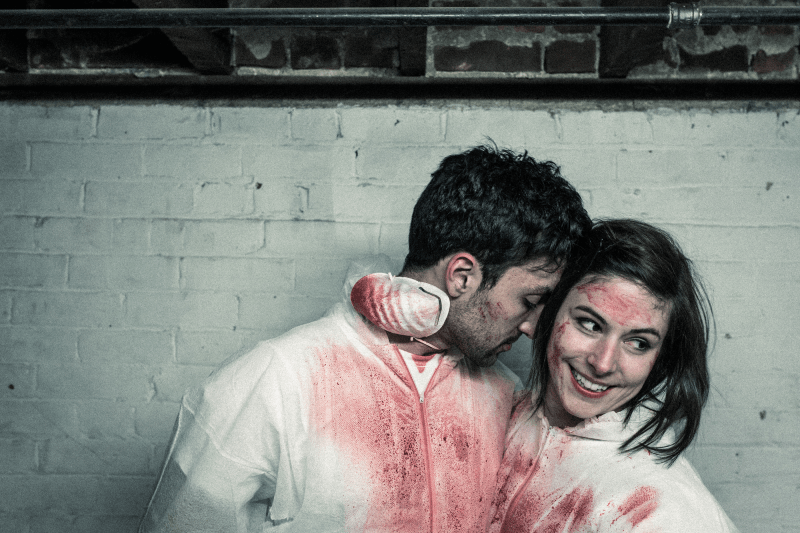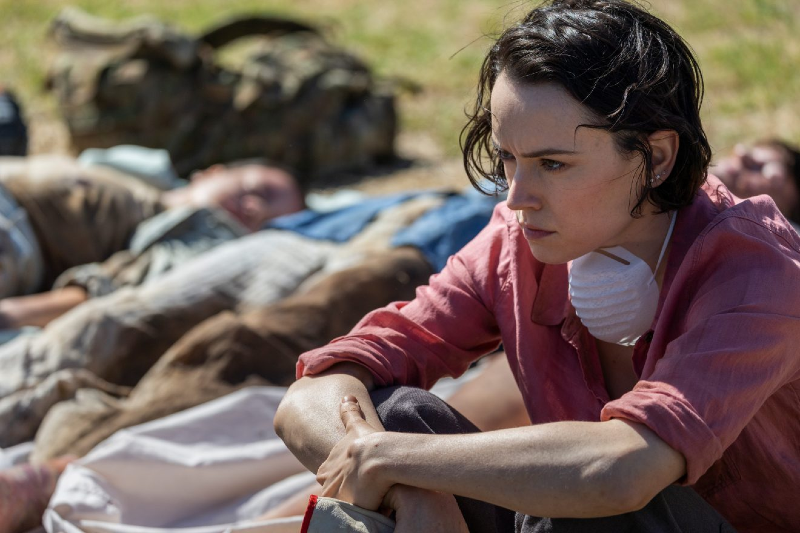The lights are dimmed, the volume is increased, and an exciting bubble of tension builds – we are ready to watch a horror film. However, sometimes, these films traverse far past the archetypal cinematic experience of lighthearted fun and fear; instead, they speak to a rooted rottenness of the human experience. Nick McAnulty and Brian Allan Stewart’s chilling found footage film Capture Kill Release embodies the notion of spectatorial participation and how hyperrealist horror weaponizes its power.
Young couple Jennifer (Jennifer Fraser) and Farhang (Farhang Ghajar) are on the hunt to fulfil their violent fantasy of killing a stranger. To keep a diary of their antics, they decide to wield a handheld camera to record every step of their journey – from the initial capture to the bloodied killing of their victim. Jennifer dives into the process with an unsettling keenness, giddy with joy as she gathers supplies to dismember their victim. On the other hand, Farhang acts as the film’s emotional mediator, often taking a more rational approach. Yet his voice of reason is far from puritan as he goes along with the butchery of their eventual target: Gary (Jon Gates), an unhoused man who was lured into their trap at the promise of a warm meal.
Across Capture Kill Release, the act of violence is treated as a rehearsal of a snuff tape, both through the film’s treatment of death as a spectacle and through the found footage, amateur-themed framing. Prominent questions concerning participatory viewership and the immediacy of the camera are brought into view.
The diegetic camera lives both inside the filmic world and out via its projection onto our screens. By proxy, there is an overt suggestion that the narrativization and aesthetics combine to create a rhetoric that indicates a growing attraction towards the immediacy and authenticity of horror cinema. In other words, the intrafilmic lens illuminates how Capture Kill Release and similar media such as The Poughkeepsie Tapes act to flesh out the burgeoning appeal that audiences have in seeking real, true, almost bonafide depictions of terror and violence.
Jennifer and Farhang drag and linger the camera to whatever image they see fit, whether that be their long discussion as they sketch out their murderous modus or the sawing of limbs in a bloodied bathtub. Essentially, where they go, we go, and what they see, we see. Here, they control our reality within the film, akin to us becoming a sporadic character that tags along for the ride. This idea of immersion and alignment is critical in decoding the film’s potent ferocity as a standout, vital piece of found footage horror.
Let it not be presumed that the viewer is unaware that the medium is fictionalised; the logic remains that we understand it is a planned sequence of events akin to any media piece. Alternatively, we are temporarily instructed to view the experience as an interactive slice of life, where the boundaries of film and reality imitate and play on the blur between fact and fiction. In an ode to the gap between the viewer and film closing, an experience is formed that is separate from that of simply watching a film – along with watching for entertainment, we are ‘feeling’ the events unfold.
The diegetic camera focuses on offering an internal look into the world of Jennifer and Farhang, where continuous POV shots and direct dialogue to the camera (the viewer’s gaze) suggest an affective alignment to the unfolding occurrences. Capture Kill Release employs an almost documentarian stance, coding itself as a realist vehicle for horror to thrive. In applying the practice of this idea towards alliance, immersion and interactive horror, one point that stands out is the importance of the content derived from this filmmaking method: the concept of hyperrealist violence. One particular scene that combines both the observational image and the notion of realism is Gary’s demise.
The scene in question displays how the lethal duo kill Gary and drag his lifeless body into the bathtub whilst Jennifer gleefully brandishes a knife and proclaims that the process is parallel to “prom night…but for murderers.” What happens next to Gary’s corpse includes jugular draining, limbs being graphically sliced through with a power saw and dumped into garbage bags, and his remains meeting their resting place in an undisclosed, muddied woodland.
Jennifer provides a running commentary throughout, joshing about Gary’s blood splashing Farhang and claiming that red is “really your colour.” Awkward, off-kilter humour aside, what is pertinent here is the film’s abundant graphic aesthetics, which deliver gore by the bucket. At its core, the simulation of explicit content, mainly through the camera’s proximity, immediately coerces us to experience a daunting, affective response.
When the subject of realism prompting extreme affect and the concept of found footage are combined, a unique, imperative and suggestive force is pushed to the forefront of cinematic theory. Upon closer inspection, when we view the imagery depicted whilst Jennifer and Farhang dismember Gary, a clear emotional response of uncomfortableness and terror is stirred amongst the audience.
While such feelings deserve attention, what bears the most significance is not necessarily the surface of these emotions but what reactions are triggered beyond the exterior. When discussing the affective plane, emotions are considered to be multidimensional; there is the preliminary gut feeling and then the deeper reaction that elicits intrinsic reactions that equip the sensory processes to facilitate an embodied reaction. Case in point, discomfort catalyses abhorrence, and terror provokes repulsion. Both feelings, on their most intense level, address how Capture Kill Release speaks to the overarching power of found footage horror.
Farhang takes the sabre saw and places it over Gary’s arm. The limb thrashes and wriggles from the vibrations of the motored weapon, splashing the gushing blood all over the bathtub before the now severed piece is thrown into the tub, joining his sodden torso and head. Even without the rest of the film, this one scene provokes us almost to feel the pain of having one’s body hacked apart. We can sense the coldness of the tub, the feeling of warm, thick blood squirting onto us, and the putrid smell of death looming in the air. We are not there and colloquially have not experienced such a fate, yet, due to the graphic, realist gore and unflinching camera that embodies our gaze and places us against the characters, we are able to become one and experience the unknowable.
Capture Kill Release bears a chilling ability to challenge the cores of horror cinema, forgoing a typical experience of shock value for shock value’s sake. Instead, it is about probing cinema’s visceral qualities. The immediacy of the diegetic lens is utilised as a tool to form a startling position of immersion that takes the viewer by the hand and drags them into the horrid world of Jennifer and Farhang. Furthering the film’s ability to envelop us in the action is the narrative’s secondary strain of potency, the matter of affect and how the gross intensity of it all enhances a corporeal experience that speaks to the horror genre’s terrifying capacity.







